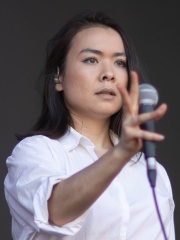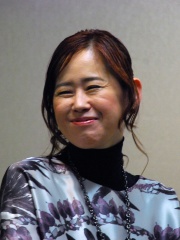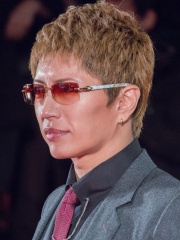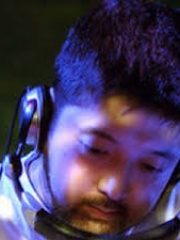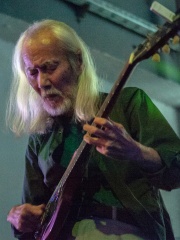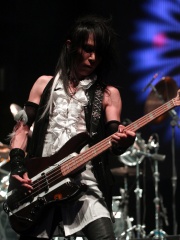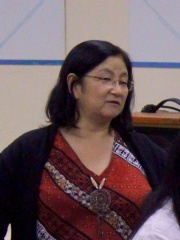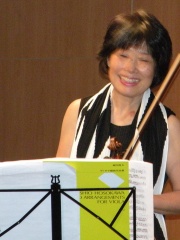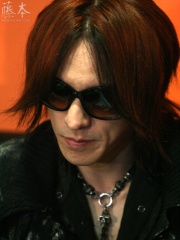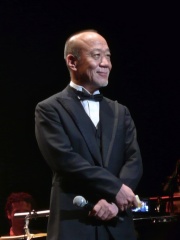
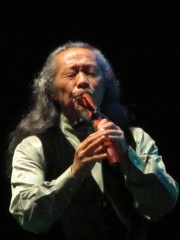
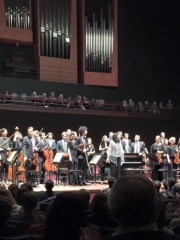
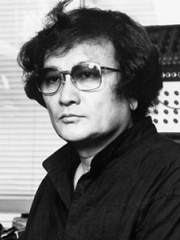
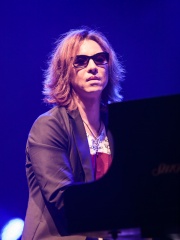
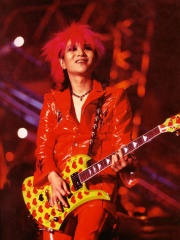
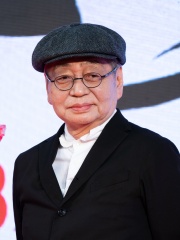
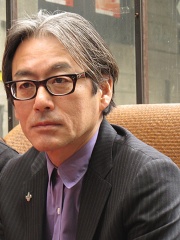
The Most Famous
MUSICIANS from Japan
Top 10
The following people are considered by Pantheon to be the top 10 most legendary Japanese Musicians of all time. This list of famous Japanese Musicians is sorted by HPI (Historical Popularity Index), a metric that aggregates information on a biography’s online popularity. Visit the rankings page to view the entire list of Japanese Musicians.

1. Joe Hisaishi (b. 1950)
With an HPI of 65.24, Joe Hisaishi is the most famous Japanese Musician. His biography has been translated into 50 different languages on wikipedia.
Mamoru Fujisawa (藤澤 守, Fujisawa Mamoru, born December 6, 1950), known professionally as Joe Hisaishi (久石 譲, Hisaishi Jō), is a Japanese composer, musical director, conductor and pianist, known for over 100 film scores and solo albums dating back to 1981. Hisaishi's music has been known to explore and incorporate different genres, including minimalist, experimental electronic, Western classical, and Japanese classical. He has also worked as a music engraver and arranger. He has been associated with director and animator Hayao Miyazaki since 1984, having written scores for all but one of Miyazaki's films. He is also recognized for his music for filmmaker 'Beat' Takeshi Kitano, including A Scene at the Sea (1991), Sonatine (1993), Kids Return (1996), Hana-bi (1997), Kikujiro (1999), Brother (2000), and Dolls (2002), and for the video game series Ni no Kuni. He was a student of anime composer Takeo Watanabe.

2. Kitarō (b. 1953)
With an HPI of 61.81, Kitarō is the 2nd most famous Japanese Musician. His biography has been translated into 42 different languages.
Kitarō (喜多郎), born Masanori Takahashi (高橋 正則) (February 4, 1953), is a Japanese recording artist, composer, record producer, and arranger noted for his electronic-instrumental music, and is often associated with and regarded as one of the most prominent musical acts of new-age music. He won the Grammy Award for Best New Age Album for Thinking of You (1999), with a record 16 nominations in the same category. He received a Golden Globe Award for the original score to Heaven & Earth (1993).

3. Mitsuko Uchida (b. 1948)
With an HPI of 56.54, Mitsuko Uchida is the 3rd most famous Japanese Musician. Her biography has been translated into 24 different languages.
Dame Mitsuko Uchida, (内田光子, [ɯtɕida miꜜtsɯ̥ko]; born 20 December 1948) is a Japanese-English classical pianist and conductor. Born in Japan and naturalised in England, she is particularly notable for her interpretations of Mozart and Schubert. She has appeared with many notable orchestras, recorded a wide repertory with several labels, won numerous awards and honours (including Dame Commander of the Order of the British Empire in 2009) and is the Co-Artistic Director, with Jonathan Biss, of the Marlboro Music School and Festival. She has also conducted several major orchestras.

4. Isao Tomita (1932 - 2016)
With an HPI of 56.17, Isao Tomita is the 4th most famous Japanese Musician. His biography has been translated into 24 different languages.
Isao Tomita (冨田 勲, Tomita Isao, 22 April 1932 – 5 May 2016), often known simply as Tomita, was a Japanese composer, regarded as one of the pioneers of electronic music and space music, and as one of the most famous producers of analog synthesizer arrangements. In addition to creating note-by-note realizations, Tomita made extensive use of the sound-design capabilities of his instrument, using synthesizers to create new sounds to accompany and enhance his electronic realizations of acoustic instruments. He also made effective use of analog music sequencers and the Mellotron, and featured futuristic science-fiction themes, while laying the foundations for synth-pop music and trance-like rhythms. Many of his albums are electronic versions and adaptations of familiar classical music pieces. He received four Grammy Award nominations for his 1974 album based on music by Claude Debussy, Snowflakes Are Dancing.
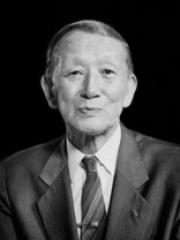
5. Shinichi Suzuki (1898 - 1998)
With an HPI of 54.94, Shinichi Suzuki is the 5th most famous Japanese Musician. His biography has been translated into 23 different languages.
Shinichi Suzuki (鈴木 鎮一, Suzuki Shin'ichi, 17 October 1898 – 26 January 1998) was a Japanese violinist, philosopher, composer, and educator and the founder of the international Suzuki method of music education and developed a philosophy for educating people of all ages and abilities. An influential pedagogue in music education of children, he often spoke of the ability of all children to learn things well, especially in the right environment, and of developing the heart and building the character of music students through their music education. Before his time, it was rare for children to be formally taught classical instruments from an early age and even more rare for children to be accepted by a music teacher without an audition or entrance examination. Not only did he endeavor to teach children the violin from early childhood and then infancy, his school in Matsumoto did not screen applicants for their ability upon entrance. Suzuki was also responsible for the early training of some of the earliest Japanese violinists to be successfully appointed to prominent western classical music organizations. During his lifetime, he received several honorary doctorates in music including from the New England Conservatory of Music (1956), and the Oberlin College Conservatory of Music, was proclaimed a Living National Treasure of Japan, and in 1993, was nominated for the Nobel Peace Prize.

6. Yoshiki (b. 1965)
With an HPI of 53.61, Yoshiki is the 6th most famous Japanese Musician. His biography has been translated into 35 different languages.
Yoshiki Hayashi (Japanese: 林 佳樹, Hepburn: Hayashi Yoshiki, born November 20, 1965), known as Yoshiki, is a Japanese musician, songwriter, composer, record producer, film director, and fashion designer. He is best known as the leader of the visual kei rock bands X Japan and the Last Rockstars, for which he is the drummer, pianist, and main songwriter. He has been described by Billboard as a "musical innovator" and named "one of the most influential composers in Japanese history" by Consequence. Yoshiki's solo career includes several classical studio albums and collaborations with artists such as George Martin, Bono, will.i.am, St. Vincent, the Chainsmokers, Skrillex, Ellie Goulding, Stan Lee, Roger Taylor and Brian May of Queen, Gene Simmons and KISS, Nicole Scherzinger, and Sarah Brightman. In 1999, at the request of the Japanese royal family, he composed and performed a classical song at a celebration in honor of the tenth anniversary of Emperor Akihito's enthronement. Yoshiki also composed the theme for the 69th Golden Globe Awards as well as for several anime and film soundtracks including Attack on Titan and Saw IV. In 2023, he made his directorial debut with the feature documentary film Yoshiki: Under the Sky. In 2023, Yoshiki was selected as the first Japanese artist to be honored with a hand and footprint ceremony at the Grauman's Chinese Theatre in Hollywood in nearly 100 years. In 2024, Variety selected Yoshiki as the International Achievement in Music honoree.

7. Hide (1964 - 1998)
With an HPI of 53.52, Hide is the 7th most famous Japanese Musician. His biography has been translated into 38 different languages.
Hideto Matsumoto (Japanese: 松本 秀人, Hepburn: Matsumoto Hideto, December 13, 1964 – May 2, 1998), known professionally as hide, was a Japanese musician, singer, songwriter, and record producer. He achieved international fame as the lead guitarist of the rock band X Japan from 1987 to 1997 and a solo artist from 1993 onward. He also formed the United States-based rock supergroup Zilch in 1996. Hide sold millions of records, both solo and as a member of X Japan. X Japan rose to prominence in the late 1980s and early 1990s, credited as founders of the Japanese visual kei movement. When they disbanded in 1997, he focused on his solo career which started four years prior and went on to enjoy significant popularity. At the height of his fame, while recording his third studio album and about to launch an international career with the newly formed Zilch, he died in 1998 of what was ruled a suicide by hanging. He was seen as an icon for Japanese youth rebelling against their country's conformist society, and his death was labeled "the end of an era".

8. Haruomi Hosono (b. 1947)
With an HPI of 52.56, Haruomi Hosono is the 8th most famous Japanese Musician. His biography has been translated into 15 different languages.
Haruomi Hosono (細野 晴臣, Hosono Haruomi, born July 9, 1947), sometimes credited as Harry Hosono, is a Japanese musician, singer, songwriter and record producer. He is considered to be one of the most influential musicians in Japanese pop music history, credited with shaping the sound of Japanese pop for decades as well as pop music outside of Japan. He also inspired genres such as city pop and Shibuya-kei, and as leader of Yellow Magic Orchestra, contributed to the development and pioneering of numerous electronic genres.The grandson of Titanic survivor Masabumi Hosono, Haruomi began his career with the psychedelic rock band Apryl Fool, before achieving recognition both nationally and internationally, as a founding member of the bands Happy End and Yellow Magic Orchestra. Hosono has also released many solo albums covering a variety of styles, including film soundtracks and a variety of electronic ambient albums. As well as recording his own music, Hosono has done considerable production work for other artists such as Miharu Koshi, Sheena and the Roketts, Sandii & the Sunsetz, Chisato Moritaka and Seiko Matsuda. In 2003, Hosono was ranked by HMV Japan at number 44 on their list of the top 100 Japanese pop acts of all time.

9. Shigeru Umebayashi (b. 1951)
With an HPI of 52.30, Shigeru Umebayashi is the 9th most famous Japanese Musician. His biography has been translated into 19 different languages.
Shigeru Umebayashi (梅林茂, Umebayashi Shigeru, [ɯmebajaɕi ɕiɡeɾɯ]) (born February 19, 1951) is a Japanese composer.Once the leader and bass player of Japan's new wave rock band EX, composer Shigeru Umebayashi began scoring films in 1985 when the band broke up. He has more than 30 Japanese and Chinese film scores to his credit and is perhaps best known in the West for "Yumeji's Theme" (originally from Seijun Suzuki's Yumeji), included in director Wong Kar-wai's In the Mood for Love (2000). Umebayashi scored most of Wong Kar-wai's follow-up film, 2046 (2004), and House of Flying Daggers. He is also the composer for the music of the first Serbian spectacle, Charleston & Vendetta. Umebayashi received the special "Tomislav Pinter Award" at Avvantura Film Festival Zadar (Croatia) in 2013 during his stay as member of the official Jury.

10. Susumu Hirasawa (b. 1954)
With an HPI of 50.87, Susumu Hirasawa is the 10th most famous Japanese Musician. His biography has been translated into 16 different languages.
Susumu Hirasawa (平沢進, Hirasawa Susumu, born April 2, 1954) is a Japanese musician and composer. He is well known for his work for the films of director Satoshi Kon and the animated adaptations of the Berserk manga series, alongside his work as a solo artist.
People
Pantheon has 50 people classified as Japanese musicians born between 1898 and 1990. Of these 50, 42 (84.00%) of them are still alive today. The most famous living Japanese musicians include Joe Hisaishi, Kitarō, and Mitsuko Uchida. The most famous deceased Japanese musicians include Isao Tomita, Shinichi Suzuki, and Hide. As of April 2024, 3 new Japanese musicians have been added to Pantheon including Haruomi Hosono, Nobuko Imai, and Sugizo.
Living Japanese Musicians
Go to all RankingsJoe Hisaishi
1950 - Present
HPI: 65.24
Kitarō
1953 - Present
HPI: 61.81
Mitsuko Uchida
1948 - Present
HPI: 56.54
Yoshiki
1965 - Present
HPI: 53.61
Haruomi Hosono
1947 - Present
HPI: 52.56
Shigeru Umebayashi
1951 - Present
HPI: 52.30
Susumu Hirasawa
1954 - Present
HPI: 50.87
Mitski
1990 - Present
HPI: 50.07
Yuki Kajiura
1965 - Present
HPI: 49.93
LiSA
1987 - Present
HPI: 47.89
Gackt
1973 - Present
HPI: 47.82
Hyde
1969 - Present
HPI: 47.14
Deceased Japanese Musicians
Go to all RankingsIsao Tomita
1932 - 2016
HPI: 56.17
Shinichi Suzuki
1898 - 1998
HPI: 54.94
Hide
1964 - 1998
HPI: 53.52
Nujabes
1974 - 2010
HPI: 46.26
Ryo Kawasaki
1947 - 2020
HPI: 45.91
Heath
1968 - 2023
HPI: 45.89
Taiji
1966 - 2011
HPI: 43.46
Naomi Munakata
1955 - 2020
HPI: 40.54
Newly Added Japanese Musicians (2024)
Go to all RankingsHaruomi Hosono
1947 - Present
HPI: 52.56
Nobuko Imai
1943 - Present
HPI: 45.98
Sugizo
1969 - Present
HPI: 42.58
Overlapping Lives
Which Musicians were alive at the same time? This visualization shows the lifespans of the 6 most globally memorable Musicians since 1700.

